Welcome to Moda Fabrics!
Sticky Stuff
Sticky Stuff
Glue basting. The first time I heard of it, I thought folks were crazy. Then I had a binding that needed to be "finished" and I didn't have the time to stitch it down. So Elmer's School Glue to the rescue.
That was the first of many glue-basted bindings. And it opened my eyes to the variety of adhesives and glues that have been created for sewing and quilting, and the potential uses.
For many years, quilters and sewists were warned about using adhesives and glues when sewing. The idea was that the action of the needle and thread passing through fabric containing glue would deposit microscopic bits of glue down into the sewing machine, eventually building up and damaging the machine. While that is a logical conclusion, I have yet to hear of that actually happening. Quilters are a chatty bunch so that kind of news would get around.
So here are some of the products that have made their way through my sewing room over the years. Some were there for just a little while, but others have remained as "essential tools".
Odif Grippy Non-Slip Coating. This isn't a fabric glue but since it will put a sticky - grippy - coating on rulers and templates, I'm counting it. If you're using a rotary cutter and rotary ruler for cutting fabric and paper, this spray coating might be your new best friend.
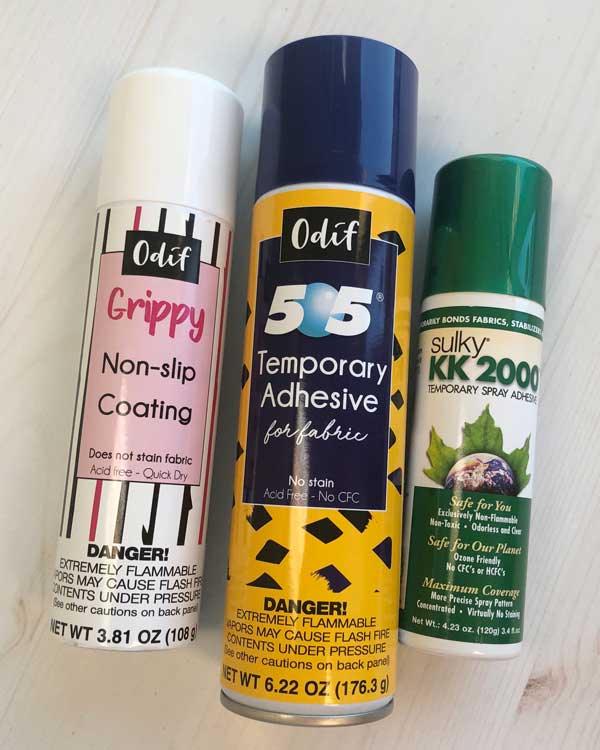
To use this, take your ruler outside and lightly spray the wrong side. Keep the can at least 8" away from the ruler, and keep it moving to disperse a light, even coating. It will dry in less than a minute, unless you get a little heavy-handed with the spray. (Been there, done that.) I like to let it dry completely, so I place it wrong-side up on a flat surface for a few minutes.
If you're worried about build-up, grippy is an acid-free, non-staining coating that washes off with soap and water. Since I like cleaning my rulers every few months, I wash off the coating and re-apply after the rulers dry. (To clean rulers, I put a few inches of warm water in my kitchen sink with Dawn soap. It really is the best soap for removing any kind of oil, including those that get transferred from our skin to every kind of surface.)
Odif is also the company behind 505 Temporary Adhesive Spray. I think many of us were first exposed to 505 spray as a way of basting layers for machine-quilting. Acid-free, odorless, colorless, non-staining, 505 spray can be used in sewing, applique, quilting and paper-crafting. It was developed more than 50 years ago specifically for use with fabric. It dries quickly and the "sticky" disappears. The adhesive breaks down during and washing, and will often disappear from the fibers over the course of several washings.
Sulky KK2000 Temporary Spray Adhesive is a similar product, except that it is more highly concentrated, and the state-of-the-art spray nozzle directs the adhesive to the fabric. There's less "over-spray" - technical term. As with all of these products, it is non-toxic, odorless and it will not stain fabric.
With machine-quilting so many pillow tops and backings in recent years, I've been using both of these spray adhesives more frequently than I used to. Why? Because I really don't like pin-basting, or the tack-thing. They both work beautifully but I prefer using 505, especially with slighly larger pieces that will be twisted-and-turned frequently during quilting. While I have used 505 for many years, I have used the Sulky more of late.

Therm-o-Web Fabric Fuse. This is a quick-bonding liquid glue. As with most of the glues, it is non-toxic, machine washable and it's dryer-safe. I tried this when I was looking for a fast-drying glue that would adhere labels and ribbons to a bag or pillow without having to be ironed. This worked nicely but I found that it wasn't quite as secure - strong - as other products.
Dritz Unique Stitch. One of my favorite products. (Thank you, Jane Stewart. An awesome Moda Sales Rep.)
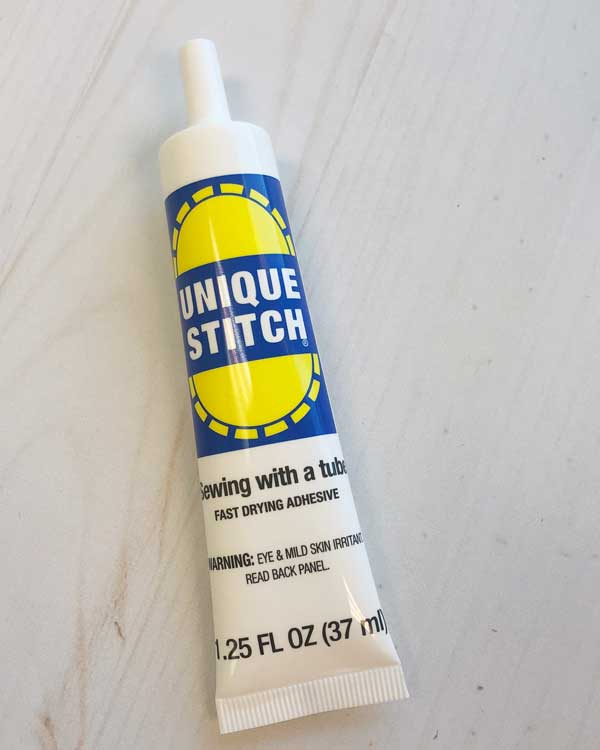
Unique Stitch can be used for anything - hems, attaching rickrack and ribbons, affixing Velcro pieces, and who knows what else. The bond is permanent, and it's very strong. There are uses where it's probably not necessary to machine-stitch the piece in place, but that's how I use it most. A couple of drops, or even a thin line of this liquid glue, lets me place the "whatever" where I want it so it doesn't move while it's being stitched in place. Pins? Those work too, but when the ribbon is narrow, or the patch is small, this non-toxic, water-soluble glue is easier to use. It also dries clear.
And for those times when you need an emergency hem that you might not get around to actually sewing, Unique Stitch can be machine-washed and dried, and the bond will last.
Dritz Fabric Glue Stick and Roxanne's Baste-It Glue. Both of these products are non-toxic and water-soluble. Both will create a fairly permanent bond when "set" with heat. And both will wash out so while they aren't temporary, they also aren't permanent in the sense that they will last through washings.
The Dritz Fabric Glue is similar to the Sewline Glue Stick - another favorite glue product - in that the stick shape and "swipe it across the surface" application method makes it easy to use. Whether it's positioning labels and trims, matching plaids and stripes before sewing, or making quick pattern alternations, glue sticks are probably the easiest products to keep in an on-the-go sewing bag. Glue sticks are lovely for glue-basting English Paper Piecing.
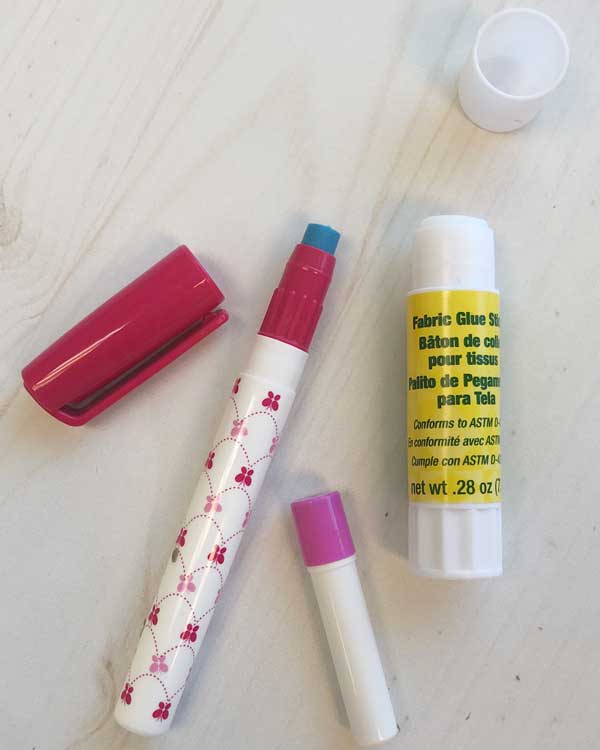
For some of the pillows I've made in recent months, I wanted to add a label using a piece of selvage. After cutting my strip and pressing a narrow hem on the long edges, I used a glue stick to keep the label in place while it was being stitched. Pins would just as well, though I found that the folded corners were easier to keep in place with glue.
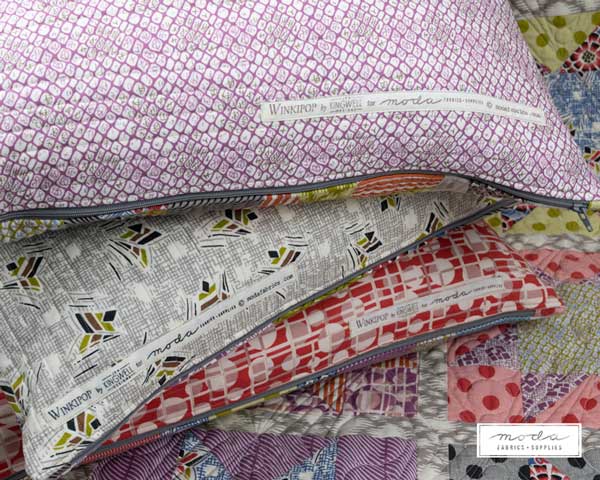
Pins can also migrate. With a glue stick, I can place the strip, then check it with a ruler to make sure it is straight. The glue from the sticks stays sticky and allows for re-positioning more easily than some of the other glues. At least that's been my experience.
And then there's Roxanne's Baste-it Glue.
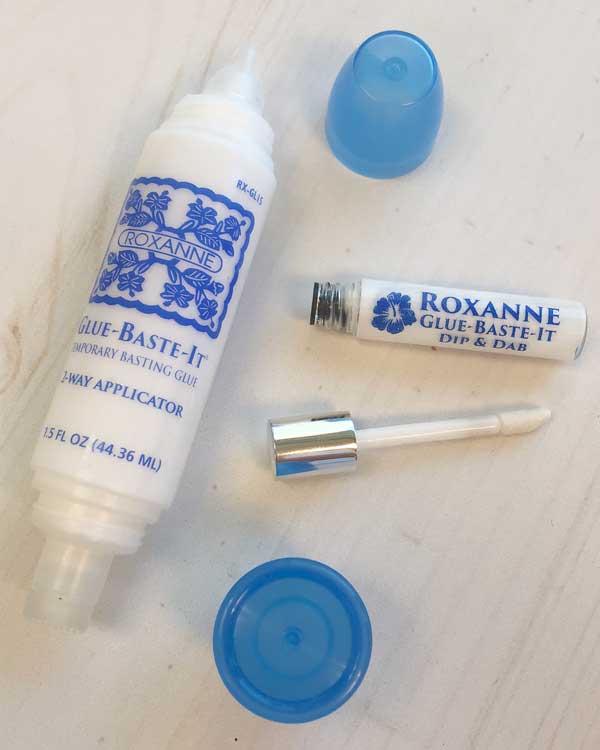
While I have used this many times in place of hand-stitching a last-minute binding, I use this more frequently when I want to match stripes for a binding or border. The glue keeps the pieces securely in place for stitching, and then can be removed with a good spray of water. If I get some glue on the front of the piece that needs to be removed, a damp cloth has always taken care of that.
For many years, I used the bottle with the very long applicator. And no matter how careful I was in cleaning it, whether I put a pin in the tube, it often clogged. I've not had any problems with the Two-Way Applicator shown here. I rarely need the very thin stream of glue the long, tube applicator could apply, so the narrow end of this suits my needs just fine. I don't use the brush side very often... like maybe, I've never used it. But others have and they like it. For those times when I need a tiny amount in a small spot, the Dip & Dab is terrific. There is also a larger Dip & Dab tube-applicator, it's almost three times the size at .34 oz.
As we do every month, we're going to share some of these products so you can try them. Or re-stock. There's one of everything we've mentioned and some Moda goodies. Because you need some fabric to glue and stick together, right?

To be entered in the giveaway, simply leave a comment by Midnight CST on Sunday, August 9. Tell us about the types of adhesives you've used. Do you have a favorite? Or are you new to the glue-game?
Have a safe, happy Tuesday.
I hope you make something that brings you joy.

Comments